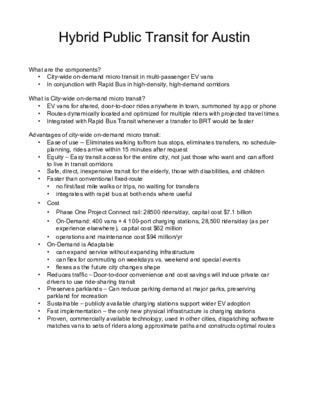11-3: Hybrid Public Transit for Austin — original pdf
Backup

Hybrid Public Transit for Austin What are the components? • City-wide on-demand micro transit in multi-passenger EV vans • In conjunction with Rapid Bus in high-density, high-demand corridors What is City-wide on-demand micro transit? • EV vans for shared, door-to-door rides anywhere in town, summoned by app or phone • Routes dynamically located and optimized for multiple riders with projected travel times • Integrated with Rapid Bus Transit whenever a transfer to BRT would be faster Advantages of city-wide on-demand micro transit: • Ease of use -- Eliminates walking to/from bus stops, eliminates transfers, no schedule- planning, rides arrive within 15 minutes after request • Equity – Easy transit access for the entire city, not just those who want and can afford to live in transit corridors • Safe, direct, inexpensive transit for the elderly, those with disabilities, and children • Faster than conventional fixed-route • no first/last mile walks or trips, no waiting for transfers integrates with rapid bus at both ends where useful • • Cost • Phase One Project Connect rail: 28500 riders/day, capital cost $7.1 billion • On-Demand: 400 vans + 4 100-port charging stations, 28,500 riders/day (as per experience elsewhere), capital cost $62 million • operations and maintenance cost $94 million/yr • On-Demand is Adaptable • can expand service without expanding infrastructure • can flex for commuting on weekdays vs. weekend and special events • flexes as the future city changes shape • Reduces traffic – Door-to-door convenience and cost savings will induce private car • Preserves parklands – Can reduce parking demand at major parks, preserving drivers to use ride-sharing transit parkland for recreation • Sustainable – publicly available charging stations support wider EV adoption • Fast implementation – the only new physical infrastructure is charging stations • Proven, commercially available technology, used in other cities, dispatching software matches vans to sets of riders along approximate paths and constructs optimal routes